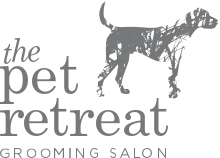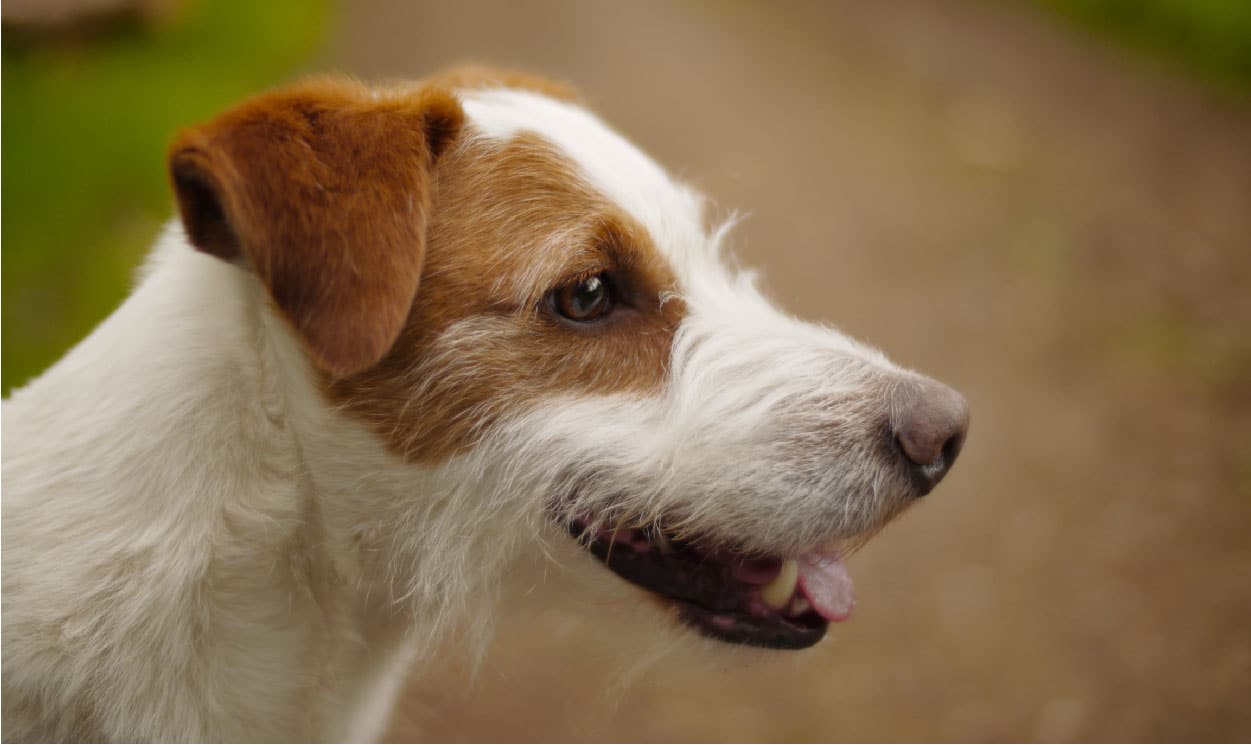Everything you need to know about wiry coat health
From Jack Russells to Irish Wolfhounds, wiry haired dog breeds will always have a place close to the hearts of many dog lovers. Some iconic breeds boast this coat type and it’s blessed with character. That said, the wiry nature of the coat can present a frustration and problem for many home groomers keen to get their pet looking ship shape.
This wiry haired grooming guide from your groomers at The Pet Retreat should give you all the information you need to keep your dog’s coat healthy and looking great.
Contents
- What is a wiry coat?
- What dog breeds have a wiry coat?
- What are the benefits of a wiry coat?
- About Handstripping
- What is required to maintain a wiry coat at home?
What is a wiry coat?
A wiry coat, sometimes referred to as a “broken coat”, feels exactly as the name suggests. The coat is rough and coarse to the touch and the hair is thick and bristly when compared to the soft coats that other dogs possess.
Wiry haired dog breeds were initially used for hunting small animals, with their rough and ready coats protecting them from sharp plants in the undergrowth. Now though they tend to be favoured by people who have dog allergies as they don’t shed their coat, unlike many other dogs. This lack of shedding creates a unique requirement for grooming however, as it’s necessary to pull the old dead hairs out using a process known as hand stripping.
What dog breeds have a wiry coat?
Many iconic dog breeds possess a wiry coat, including the iconic Jack Russell and Yorkshire Terrier breeds. Here’s an example of a few breeds that have a wire coat:
- Schnauzers
- Border Terriers
- Cocker Spaniels
- Jack Russells
- Irish Wolf Hounds
- Wire Fox Terrier
- Wire-haired Pointers
- Wire-haired Dachshunds
Some wiry haired dog breeds have a less harsh variety of wiry hair than others, but it’s still best advised to follow the same grooming practices in order to help their coat remain healthy.
What are the benefits of a wiry coat?
There are a range of benefits that come with owning a dog with a wiry coat, some of which we’ve already discussed, including: –
- Less shedding – unlike many other dog’s they don’t shed their coat which means less of those pesky dog hairs around the house.
- Hypoallergenic – due to the fact that they don’t shed hair, they are a great choice for anyone who is allergic to dogs
- More protection – their wiry coat provides them with a barrier of protection against plants and other rough objects when out walking.
About Handstripping
To groom a wiry haired dog breed we’ll use a method known as handstripping. This is a time intensive grooming technique that requires older hairs to be pulled out of the coat by hand or using a grooming knife. The process can take any time up to two hours depending on the dog breed. You can find the pricing for our handstripping by using our online quote tool.
The stages of hair growth in wiry coat breeds
Handstripping helps support the healthy growth of hair, but it’s helpful to understand how it helps. To do this let’s first explain the four stages of hair growth in dogs.
- Anagen Phase – this is when hair follicles move into the GROWTH PHASE
- Catagen Phase – this is the TRANSITION PHASE when hair stops growing and the outer root sheath attaches to the hair
- Telogen Phase – the RESTING PHASE when the hair is at a standstill and does not grow or shed
- Exogen Phase – this is the FALLOUT PHASE where the hair falls out and new hair grows
Why is handstripping the best method for wiry haired dogs?
Handstripping targets the older hairs that are in the exogen phase of growth. These older dull hairs are easy to pull out and by doing so they leave room for new stronger hairs to grow through. This ensures that the coat will have a fuller, shinier texture and a more vibrant colour
It’s recommended instead of clipping or scissor cutting because rather than removing old hairs these methods simply cut the old dull hairs. In doing so fresh new hairs don’t have the room to grow through. More importantly, by clipping your wiry haired dog’s coat you can prevent the coat growing properly and it may not be possible to handstrip in future.
Preparing for the handstrip
For the handstripping to be performed, it’s important that your dog has a dry coat. This ensures that the hairs can be stripped out without causing discomfort and avoids issues that may impact the final result. We’ll usually give your dog a brush down before we start with a slicker brush to ensure no errant clumps of dirt remain in the coat and as with all grooms we’ll give their overall skin and coat health a once over before starting. We’ll then dust them with chalk which helps improve grip to aide the stripping process.
The Technique
The aim of handstripping is to remove the older dull hairs that are in the exogen phase and are easier to pull out. To do this we use a stripping knife, grooming stone or by hand using a finger condom for grip. When performed by our professional groomers handstripping is completely painless for your dog.
We’ll focus on removing hairs from their back and sides first as this is the easiest area to pull with a stripping knife. We’ll then move on to harder to reach sections and remove the hairs by hand or by using a specialist grooming stone. This is where our expertise comes into play as we remove the tricky areas and give your dog the tidy all around finish that they deserve.
Finishing Touches
To finish the groom we’ll give your dog a brush down to remove any final loose hairs that are resting on top of the skin. Clipping should always be kept to a minimum when grooming wiry coated breeds, but we may tidy tender or hard to reach areas with a clipper or scissors. Some breeds have softer hair on their underbelly which we will often use scissors for. If you’d like your dog to benefit from any of our treatments, these will be applied once the groom is complete if not done before.
What is required to maintain a wiry coat at home?
Following your visit to The Pet Retreat, it’s important that you maintain your pet’s coat at home. You can purchase a range of tools from our salons to help you keep on top of things until your next appointment. If you have any questions, just ask your groomer and they’ll be happy to show you the best tools for the job.
Wiry Breed Shampoo
It’s important that you don’t bathe a wiry coat too often because it can cause the hair to dry out. When you bathe your dog, it’s important that you use a shampoo specifically formulated for wiry haired breeds due to the unique makeup of their coat. If your dog is dirty, it’s worth bathing and drying before grooming to make the job easier.
Wiry coat breeds also have different skin to many other breeds, which brings with it a host of separate care considerations, all of which should be taken care of with wiry breed shampoos. There are a range of brands out there, here at The Pet Retreat we use Wildwash Shampoos, all of which are made from natural ingredients.
Detangling Comb
It’s common for wiry dog coats to become tangled, especially around hard to reach areas such as the armpits. For this purpose it’s always worth having a detangling comb to hand. These special grooming tools help unmatt the fur. When using the comb be gentle and focus on the end of the hairs first, working your way down and closer to the skin. Matted hair can hurt a dog when pulled so take your time to cause as little stress as possible.
Slicker Brush
Although a wiry haired dog breed does not need the same day to day maintenance that many longer haired breeds require, it’s still important that you keep a regular brushing routine. For this we recommend a slicker brush. These are made up of thin wires that are angled away from the pet’s skin. They help dematt the fur and remove any debris or dead hairs that may be resting on the skin. For wiry breed dogs we recommend using a slicker brush with fine bristles.
How Do You Groom Other Types of Dog Coats?
As grooming is such an essential part of your dog’s health and happiness, it is very important to keep up with a regular schedule at home. Professional sessions are equally as important, so why not book an appointment with The Pet Retreat’s experts or read our detailed guides for different coat types?
Combination Coat
Border Collies, Tibetan Spaniels and Cocker Spaniels are all breeds with combination coats. These have the benefits of being easier to maintain than a longer coat, but need a set routine to keep their coat healthy. Follow our comprehensive guide on combination coats to keep your dog’s healthy shine.
Double Coat
Dogs with double coats shed a large amount of hair compared to other breeds, which means you will have to attend more regular grooming sessions. Home grooming is just as important as professional sessions, so make sure to read our guide on grooming dogs with double coats.
Long Coat
If you own a long haired dog, you may notice that they get dirty often due to the length reaching close to the floor. Make sure to keep up with regular professional grooming sessions and home grooming to keep their coat looking healthy. Our guide on grooming for long coats includes everything you need to know about maintaining your dog’s hair.
Wool Coat
Cockapoos, Labradoodles and Poodles are a few of the breeds with the beautiful curliness of wool coats. Maintaining a consistent home grooming routine and attending regular professional sessions is an integral part of your dog’s happiness and health. Follow our comprehensive guide for wool coats to properly care for your dog’s wool coat.
Smooth Coat
Dogs with smooth coats are the easiest to maintain as they won’t get tangled or matted, and rarely shed. Some breeds in this category include Great Danes, Beagles and Dalmatians, so read our blog if you own one of these dogs as we discuss the correct products to use and how to properly groom their coat.
Book a Combination Coat Appointment
We offer a complimentary consultation at The Pet Retreat so we can cater our expert service to your dog’s coat. Using only natural products, our grooming sessions place your dog’s safety and happiness at the heart so you can rest assured your dog is in safe hands. Book a session today.

